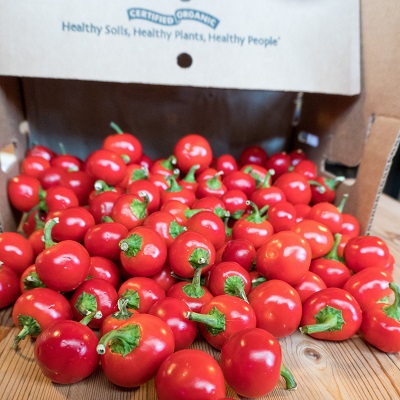With their signature heat, attractive appearance, and nutritional benefits, hot chili peppers have become an increasingly popular produce category in the US on both the conventional and the organic side.
“As Americans are looking for more flavorful dishes, and in many cases are inspired by ethnic cuisines, hot peppers have been doing well in recent years,” says Anne-Marie Roerink, principal and founder of 210 Analytics.
Anne-Marie Roerink, principal and founder, 210 Analytics
In analyzing IRI MULO data on six hot pepper varieties, 210 Analytics found that all of them showed positive growth in 2019 compared to the previous year as well as compared to three years prior. For example, 2019 jalapeno sales increased by 15.9 percent from 2018 and 22.2 percent from 2016.
San Francisco-based distributor Veritable Vegetable saw its sales of organic jalapenos jump by an impressive 50 percent in 2019 compared to the previous year. In addition to the jalapeno, which is its most popular variety, Veritable also sells a number of other chili pepper types, including the serrano, habanero, poblano, cayenne, Anaheim, Cherry Bomb, Padron, Carolina Reaper, Fresno, New Mexico-grown Hatch, Flamingo, and Gypsy.

Jacobs Farm del Cabo shishito peppers
“There is no pepper we will not sell here at Veritable Vegetable!” says buyer Qiana Cameron. “We love our chili peppers.” Cameron attributes their rise in popularity to a number of factors, including increased use in both sauces and pickled products and their inclusion in meal kits, a growing segment of Veritable’s customer base.
“We’re also seeing an expanding discovery of food literacy, and more interest in flavor and in a broader diversity of flavors,” says Cameron, who adds that the organic produce industry in general has been increasingly serving ethnic markets. “Overall, we’re seeing more interest in health and nutrition and cooking—and who doesn’t need some extra oomph in the kitchen?”
Down the coast in Los Angeles, Heath & Lejeune has seen an increased demand for organic hot peppers as well. “Day in and day out we sell jalapenos,” says David Weinstein, Heath & Lejeune’s director of procurement, adding that the company also sells a number of other varieties such as habaneros, poblanos, serranos, shishitos, red cayennes, Anaheims, Padrons, and Corno di Toros.
David Weinstein, director procurement, Heath & Lejeune
“It is a growing category,” says Weinstein. “I don't think we know what the limits are in terms of tonnage or variety. Growers are still experimenting to figure out what the most popular varieties are and what new varieties they should adopt.”
Jacobs Farm Del Cabo is a top supplier of organic hot chili peppers to the US and has been growing chilies since its Del Cabo farming cooperative was founded in 1986. The locations of the cooperative’s farms in Baja and other parts of Mexico allow it to offer a year-round supply of Cherry Bombs, jalapenos, padrons, serranos, shishitos, and other varieties.
“As regional cuisines have become more globalized, consumer preference for foods that incorporate heat has increased significantly,” says Aaron Brookes, director of sales and marketing at Jacobs Farm Del Cabo. “To meet growing chili demand, we are focused on developing emerging markets, exploring new varieties, and expanding our farming capabilities.”

Aaron Brookes, director of sales and marketing, Jacobs Farm Del Cabo
Just last year, the company debuted the Cabo Diablo Hot Pepper Medley, an 8-ounce mixed pack of organic and fair trade specialty hot peppers—including Sugar Rush Peach, Lemon Spice, and Brazilian Atomic Starfish, among others.
Earl’s Organic distributes Jacobs Farm Del Cabo’s chilies as well as those from a number of other growers, such as Tutti Frutti Farms, La Granjita Organica, Riverdog Farm, Comanche Creek Farms, Covilli, and Aztlan Organic and Rico Farms (both via Bridges Produce).
“As regional cuisines have become more globalized, consumer preference for foods that incorporate heat has increased significantly." -Aaron Brookes
“We sell more [hot peppers] than ever,” says Robert Lichtenberg, Earl’s director of purchasing, noting that the top-selling variety is the jalapeno. He says Anaheims and poblanos also have good movement and that shishitos and Padrons have been selling increasingly well because “they’re popular at restaurants, and you can grill them.” Annually, Earl’s sells about 100,000 pounds of chilies, a number that Lichtenberg says will continue to grow.

Robert Lichtenberg, director of purchasing, Earl's Organic Produce
Over on the East Coast, Baldor isn’t seeing the same feverish level of demand for organic hot peppers, which Patrick Ahern, Baldor’s director of procurement/pricing and administration, says could be due to its majority foodservice clientele. Barret Lang, director of sales and purchasing at North Carolina-based distributor Happy Dirt, describes demand for organic hot peppers as “steady” and says jalapenos are the biggest mover.
"Most hot peppers are sold conventionally grown; only in the last five years have organic hot peppers really started up,” says Lang. “However groups like Covilli are starting to make headway and push the market.”
Covilli currently offers organic jalapenos, poblanos, serranos, habaneros, Anaheims, Cherry Bombs, and Caribes, all of which are grown in Sonora, Mexico and are available October–May. The company is planning on offering a new variety of habanero next growing season and is also conducting trials this summer in two different locations in Mexico with the goal of making its chili program year-round.

Jacobs Farm del Cabo cherry bomb peppers
“We are selling our hot peppers from coast to coast and even a few to Canada,” says Covilli president Alex Madrigal, adding that he’s observed that the greatest demand for organic hot peppers is “by far” in the Pacific Northwest. “They really enjoy their heat up there,” he says.
Kevin Byers, senior produce merchandiser at PCC Community Markets located in the greater Seattle area, would certainly agree. PCC carries 10 varieties of organic chili peppers, and Byers says all of them have shown sales growth of 25–50 percent since 2019.

Kevin Byers, senior produce merchandiser, PCC Community Markets
He attributes this significant jump in demand to a number of factors, one of which is the coronavirus crisis. “Hot peppers have been a favorite of chefs and restaurants for years, and with the closure of these establishments, many people are recreating their favorite dishes at home,” he explains.
“I also think many people are realizing how versatile hot peppers can be, and I think there has been increased exposure to the different types of hot peppers, and how to use them,” he says. “Jalapenos are still the most popular, but we are seeing large increases in the other varieties. I think more people are realizing that behind the heat of hot peppers is a tremendous amount of flavor that really adds to the depth of the dishes they are creating.”






